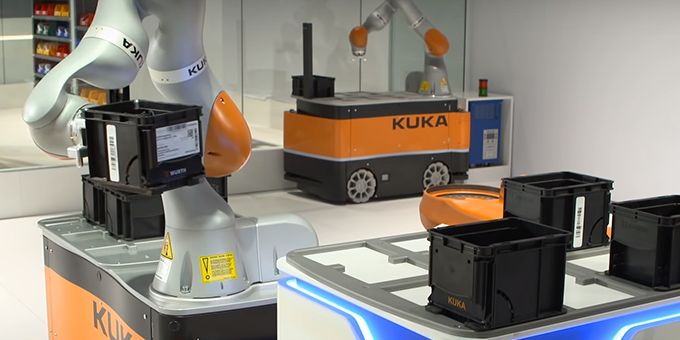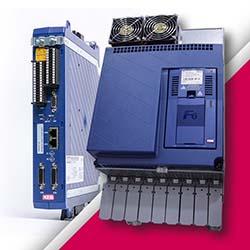Mobile robots move around a factory floor independently without any cages in order to perform their tasks. Despite not having fencing around them, mobile robots are completely safe to use alongside humans in the workspace.
 Mobile Robots and the Smart Factory
Mobile Robots and the Smart Factory

Joe Gemma | KUKA Robotics
Tell us a bit about KUKA Robotics and your role in mobile robotics?
KUKA Robotics is a global supplier of automation solutions. We specialize in building robots that are used in the automotive, welding, electronics, medical and manufacturing industries. We understand that flexibility and efficiency are important values to our customers, so we develop mobile robot solutions that support these core values. Mobile robots especially provide value for internal logistics, as they provide flexibility that traditional transport systems like fixed conveyor systems cannot. This is true in several industries, even one of the largest users of robotics and automation; the automotive industry. Overhead fixed transport conveyor systems still have value, but limitations on flexibility.
What do you mean by mobile robots in the industrial / factory setting?
Mobile robots move around a factory floor independently without any cages in order to perform their tasks. Despite not having fencing around them, mobile robots are completely safe to use alongside humans in the workspace. Sensors notify when the platforms to shut off or slow down when a worker approaches, allowing the mobile platform to work on its own to improve efficiency without posing a risk to the other factory workers.
When would a company want to invest in mobile robots over traditional robots?
Stationary robots still have their place on the factory floor, particularly when it comes to assembly line production or tasks that don’t require a lot of flexibility. Mobile robots systems are preferable when a company is looking for independent robots that can move about freely, integrating themselves more into the workforce. They can adapt to any environment, which is especially useful when a manufacturing environment is always changing.
What benefits do mobile robots provide end-users?
The most notable benefit of mobile robots is their flexibility and adaptability. Manufacturers can customize these solutions based on their own unique needs to ensure they’re getting the most out of their mobile robots. Mobile robots offer turnkey solutions to improve overall efficiency through their precision, agility and autonomy. In fact, its maneuverability shortens throughput times and reduces idle times in the manufacturing process.
How are mobile robots impacting the growth of smart factories?
With the smart factory market expected to exceed $339 billion in sales revenue in the next ten years, manufacturers are taking the next steps toward building smart factories, and advanced, customizable technologies like mobile robots can help them do exactly that. Smart factories are meant to work with you, and with mobile robots’ autonomous navigation and precision, they become an essential tool for manufacturers to improve efficiency and cut down on production time.
Which industries particularly benefit from mobile robots' capabilities?
Perhaps the most interesting development with this technology is that it can be used across many industries, from food and beverage to medical to automotive. The technology is transformational in that it allows for moving the automation to the process. Historically, the process or product was presented to a fixed automation cell, but now we can move the automation technology to the process. We can even address areas that were once difficult to work with, like polishing wind turbine blades that used to require multiple people.
What should purchasers be looking for when buying a mobile robot?
Safety is the number one thing to look for when investigating the use of a robot. When properly evaluated and used correctly, this technology can be very productive and safe. If you’re considering mobility and mobile robot platforms, you should understand the navigation capabilities of the system as well as the fleet management capabilities.
Is KUKA involved in any other advanced projects that you would like to discuss here?
More and more we are seeing the requirement for collaborative and traditional industrial robots integrated into the mobile platform solution to solve automation and manufacturing challenges. We’ll see more solutions provided to address this need across a variety of market areas.
 About Joe Gemma
About Joe Gemma
Joe Gemma is the Chief Regional Officer at KUKA Robotics. His primary role is to oversee strategy and sales growth in North America, encouraging collaboration across teams and enhancing the customer experience with quality service, products and a committed professional team. Joe has been at KUKA Robotics since 2014 and previously worked as the CEO at Staubli Corporation and EVP of sales and marketing at ATS. He earned his degree in business management from Rhode Island College.
The content & opinions in this article are the author’s and do not necessarily represent the views of ManufacturingTomorrow
Featured Product

